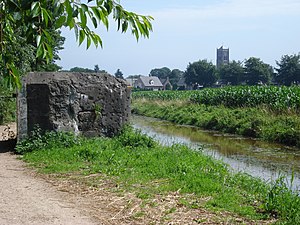Battle of Mill
| Battle of Mill | |||||||
|---|---|---|---|---|---|---|---|
| Part of the Battle of the Netherlands | |||||||
 Ruins of a Dutch casemate near Mill |
|||||||
|
|||||||
| Belligerents | |||||||
|
|
|
||||||
| Commanders and leaders | |||||||
|
|
|
||||||
| Strength | |||||||
| ~2,000 troops | ~30,000 soldiers 1 armored train 1 troop train 37 bombers |
||||||
| Casualties and losses | |||||||
| 30 killed 50 wounded |
500+ killed and wounded 1 armored train derailed 1 troop train destroyed |
||||||
|
Civilian casualties: 9 civilians were killed in the village, and heavy damage was sustained to the surrounding farms |
|||||||
The Battle of Mill was a day long struggle in and around the Dutch village of Mill along the Peel-Raam line on the first day of the invasion of the Netherlands. Although the Germans broke through, they suffered heavy casualties and were delayed in their advance by one day.
German forces favored an attack on Mill in North Brabant for several reasons. The eastern approach was covered by thick forest, there was no swampland in front, and once inside there would be a number of roads and nearby railway that could be used to push westward.
Covering the Peel-Raam Line in the area was an anti-tank ditch lined with barbed wire and 47 casemates. The line was manned by 2 battalions, equipped with four 57mm field guns. These were supported by an artillery battalion station west of Mill, armed with twelve 84mm field guns. A company of engineers was also stationed in the area, responsible for barricading roads and prepping bridges for demolition. They were equipped with a special railway barricade referred to as "asparagus". During the battle smaller units would be ordered to reinforce the position at Mill. It was planned that they be backed up by the Dutch 3rd Army Corps, but this was not to be. Overall, the Dutch would utilize approximately 2,000 men.
The Germans planned to spearhead the assault with two trains carrying the 3rd battalion of the 481st regiment. They were to be shortly thereafter joined by the rest of the 256th Infantry Division. However, issues with transportation over the Maas river would mean that the whole division wouldn't reach Mill until noon. They would be without their heavy artillery.
The German armored train and troop train passed through the border unopposed and arrived in the town of Zeeland at 04:30. The Dutch forces, unaware of the invasion, had been completely surprised and didn't have time to open fire. The German troops disembarked at the Zeeland train station and radioed that they had successfully penetrated the Dutch lines. Disappointed that they hadn't made contact with the Dutch, they shunted the armored train around and sent it back to the border. Now fully aware of the situation, Dutch engineers installed the asparagus barricade over the tracks and reinforced it with several mines.
...
Wikipedia
